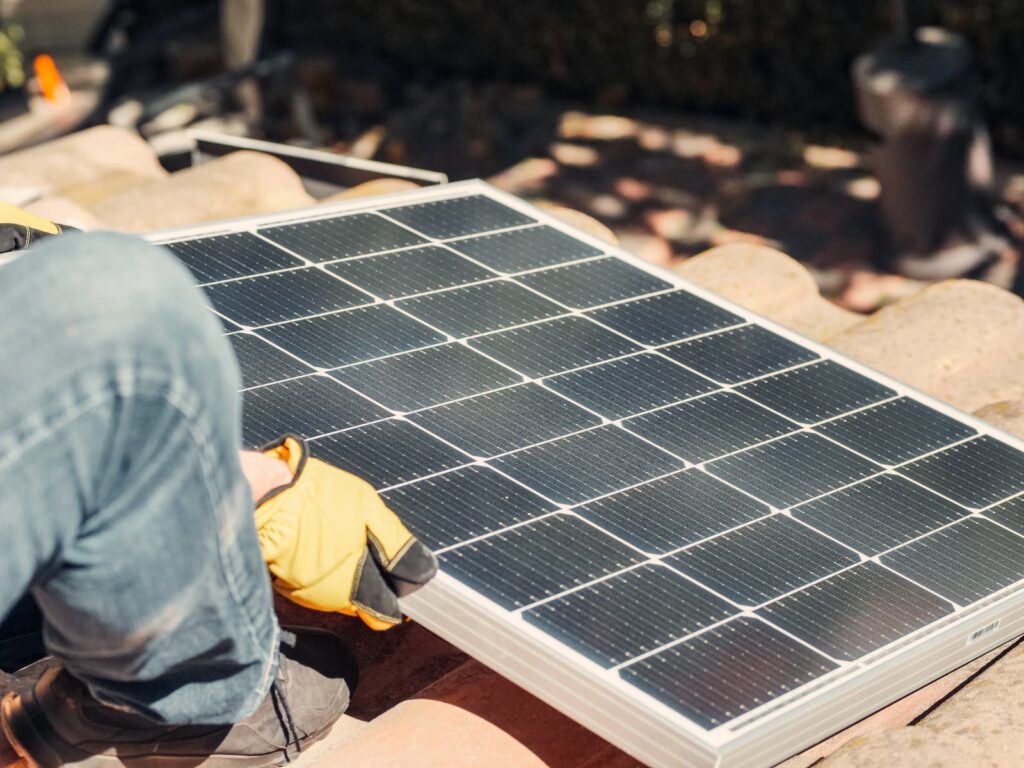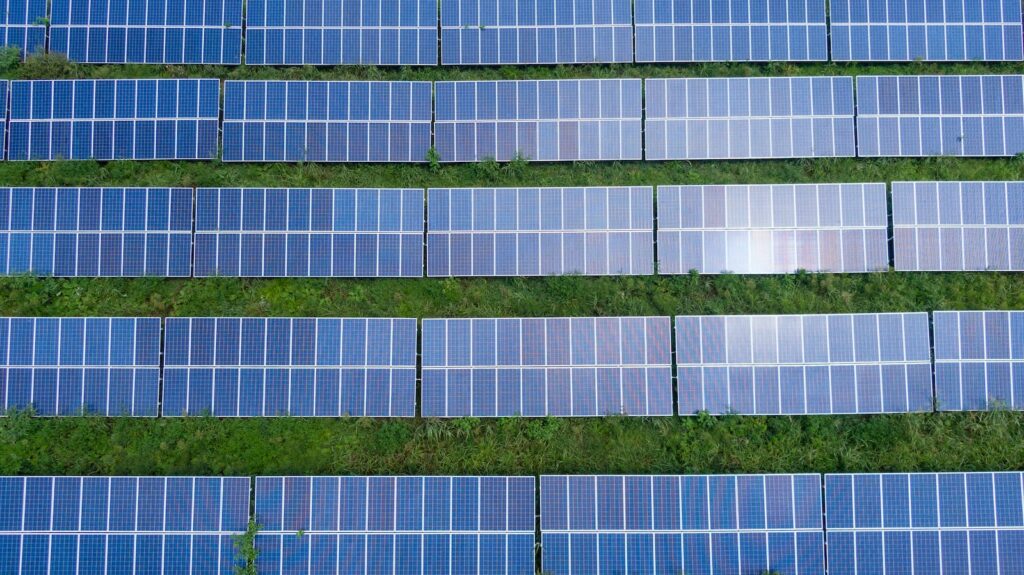In this guide, we’re diving deep into the heart of off grid solar setups: Solar Panels. Whether you’re just starting to dream about going off grid or you’re a seasoned veteran, this guide is your one-stop-shop for all things solar panels.
Table of contents
Types of Solar Panels
Monocrystalline Solar Panels

Material Composition: Monocrystalline panels are made from single-crystal silicon. This single-crystal structure allows for the free and unobstructed flow of electrons, which in turn results in higher efficiency.
Manufacturing Process: The manufacturing of monocrystalline panels usually involves the Czochralski method, where a single crystal of silicon is pulled from molten silicon. The process results in large cylindrical ingots, which are then sliced into wafers. These wafers are then treated and made into cells, which are finally assembled into panels.
Efficiency: Because of the high-quality silicon and fewer grain boundaries, monocrystalline panels are the most efficient, typically around 15-20%.
Lifespan: 25-30+ years
Factors Affecting Lifespan:
- Built with high-grade silicon, making them more durable.
- Less prone to hot spots compared to polycrystalline panels.
Common Applications:
- Residential rooftop installations: High efficiency means you get more power per square foot, ideal for limited space.
- Commercial power plants: Often chosen for large-scale operations due to their longevity and efficiency.
- RVs and boats: Their high efficiency and smaller size make them ideal for mobile applications where space is at a premium.
- Portable solar generators: Used in smaller, portable units that need to generate a lot of power without taking up much space.
Notes:
- Tend to show very little decrease in efficiency over time, often less than 0.5% per year.
- Usually come with warranties that guarantee they’ll produce at a certain percentage of their original output after 25 years.
Summary: These are the cream of the crop, manufactured from a single crystal structure. They offer the highest efficiency rates, typically around 15-20%, but come with the highest cost.
Polycrystalline Solar Panels

Material Composition: Polycrystalline panels, also known as multi-crystalline panels, are made from multiple crystals of silicon melted together. These multiple crystals create boundaries for electron flow, leading to lower efficiency.
Manufacturing Process: Silicon is melted and poured into a cast. As it cools, multiple crystals form. The resulting block is then sliced into wafers, treated, and assembled into panels.
Efficiency: Due to the grain boundaries arising from multiple crystals, the efficiency is generally lower, ranging between 13-16%.
Lifespan: 20-25 years
Factors Affecting Lifespan:
- Slightly less efficient, and efficiency tends to degrade faster over time compared to monocrystalline panels.
- More sensitive to high temperatures and shading.
Common Applications:
- Large-scale utility projects: Often used where space isn’t a premium, and initial cost is a more important factor than efficiency.
- Residential setups with ample space: If you have a lot of space on your roof or property, you can opt for the less expensive polycrystalline panels.
- Agricultural setups: Often used in farm settings where there is plenty of available land for larger solar arrays.
Notes:
- Usually less expensive than monocrystalline panels, but you may end up needing to replace them sooner.
- Also often come with warranties, although they might not be as long-lasting as those for monocrystalline panels.
Summary: Unlike monocrystalline panels, these are made from different crystal structures. They’re generally less efficient, usually between 13-16%, but come at a mid-level cost.
Thin-Film Solar Panels

Material Composition: These are made from a variety of materials, not just silicon. Common materials include amorphous silicon (a-Si), copper indium gallium selenide (CIGS), and cadmium telluride (CdTe).
Manufacturing Process: Thin-film panels are made by depositing a thin layer of the photovoltaic material onto a substrate like glass or plastic. This can be done through various methods like chemical vapor deposition (CVD), sputtering, or evaporation.
Efficiency: These are generally the least efficient, with a range of about 10-12%, although some specialized types like CIGS can reach higher efficiencies.
Lifespan: 10-15 years
Factors Affecting Lifespan:
- Less durable than crystalline panels.
- More prone to degradation, which can be accelerated by exposure to moisture or high temperatures.
Common Applications:
- Commercial buildings: Often used as building-integrated photovoltaics, like solar windows or facade elements.
- Portable chargers: Lightweight and flexible nature makes them good for small, portable charging devices.
- Off-grid remote applications: Useful in settings like remote monitoring stations where high efficiency isn’t crucial.
- Temporary setups: Used in field operations for temporary power generation.
Notes:
- Thin-film panels are lighter and more flexible, but they generally don’t last as long as crystalline panels.
- Their efficiency also degrades faster, often losing 1% or more of their efficiency per year.
The Basics: These are the most budget-friendly but offer the lowest efficiency (about 10-12%).
Solar Panel Costs
Prices can vary widely, but here’s a rough breakdown:
- Monocrystalline: Expect to pay $1 to $1.50 per watt.
- Polycrystalline: Around $0.80 to $1 per watt.
- Thin-Film: As low as $0.60 to $0.80 per watt.
Don’t forget to factor in installation, inverters, batteries, and other accessories. This cost estimate is for the panel alone.
Complexity in Installation and Maintenance
Installation
Monocrystalline and Polycrystalline
- Mounting Structures Required: Installing monocrystalline and polycrystalline panels usually involves using racking systems that are anchored to your roof or ground. These structures provide the needed stability and are a must for secure installation.
- Angle and Direction Matter: The efficiency of these panels relies heavily on the angle at which they’re installed as well as the direction they face. Ideally, you’ll want them facing south if you’re in the Northern Hemisphere to maximize sun exposure. Professional installation often involves calculations to determine the best angle for your specific location.
- Complexity: While installing these panels is more on the complex side, it’s not impossible for experienced DIYers. You’ll need some basic electrical knowledge and the right tools, but with careful planning, you can certainly make it a weekend project.
Thin-Film
- Ease of Installation: Thin-film panels are considerably easier to install. Some are even available as peel-and-stick products that can be directly attached to a surface without the need for mounting structures.
- Versatility: Because they’re lightweight and flexible, thin-film panels are a great option for unconventional spaces like curved roofs, portable setups, or even for temporary installations like events or camps.
Maintenance
All Panel Types
- Low Maintenance Overall: Whether you choose monocrystalline, polycrystalline, or thin-film, all solar panels require relatively low maintenance. This generally involves cleaning the panels to remove dust, dirt, or snow, ensuring that they’re capturing as much sunlight as possible.
- Periodic Checks: It’s a good idea to have your system checked by a qualified technician at least once a year. They can inspect for any potential issues like loose connections or wear and tear that could affect performance.
Thin-Film Specifics
- Frequent Replacement: One thing to consider with thin-film panels is that they typically have a shorter lifespan compared to their crystalline counterparts. As a result, you may find yourself replacing them more often, which could be a factor in long-term maintenance costs.
All types of solar panels require relatively low maintenance, mainly cleaning and occasional checks by a technician. But Thin-Film might require a bit more frequent replacement due to its shorter lifespan.
Solar Panel Output: What to Expect
The amount of electricity you can generate will depend on several factors including panel type, size of the installation, and local weather conditions.
- Monocrystalline: High efficiency, expect up to 20% conversion of solar energy to electricity.
- Polycrystalline: Moderate efficiency, up to 16% conversion.
- Thin-Film: Lower efficiency, around 10-12% conversion but can be higher in some specialized types like CIGS (Copper Indium Gallium Selenide).
Calculations and Conversions
Capacity
The capacity of a solar panel is the maximum amount of electricity that it can produce at any given moment under ideal conditions. This is usually measured in watts (W) and is often indicated on the label or technical specifications of the panel. For instance, a 300-watt solar panel can produce up to 300 watts of electricity when it’s exposed to full, direct sunlight and operating at peak efficiency.
Daily Production
On the other hand, daily production is the total amount of electricity that a solar panel produces over the course of an entire day. This is measured in kilowatt-hours (kWh). Various factors such as the angle of the panel, weather conditions, and the number of daylight hours can affect the daily production.
For example, if a 300-watt panel operates at its full 300-watt capacity for 4 hours during the day, it will produce 1.2 kWh of electricity for that day (300 watts x 4 hours = 1200 watt-hours or 1.2 kWh).
It’s important to note that a panel’s capacity is a peak or maximum figure, and the panel will not operate at this capacity all the time. The daily production gives a more realistic estimate of the energy you can expect to harness from the panel over an entire day, under average conditions.
So, in summary:
- Capacity: The maximum electricity output of a solar panel at any given moment, measured in watts.
- Daily Production: The total amount of electricity generated by a panel over an entire day, measured in kilowatt-hours.
Both metrics are crucial for evaluating the suitability and efficiency of a solar panel for your needs.
We hope you enjoyed this guide to the different types of solar panels and considerations to take into account when planning your off grid solar adventure.
